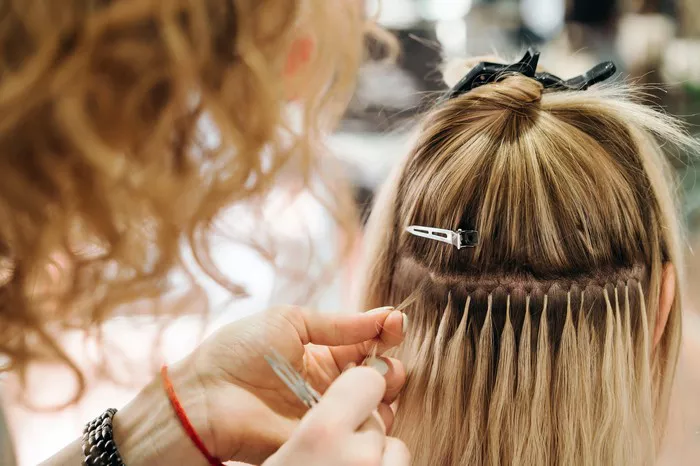Hair extensions are a fantastic way to add length, volume, and versatility to your natural hair. Whether you’ve opted for tape-ins, clip-ins, or sew-ins, proper maintenance is crucial to ensure the longevity and health of both your extensions and your natural hair. In this comprehensive guide, we’ll explore the essential aspects of hair extension maintenance, covering washing, styling, and sleeping practices to keep your extensions looking fabulous.
I. Understanding Hair Extension Types:
Before delving into maintenance routines, it’s essential to understand the type of hair extensions you have. Different methods, such as tape-ins, clip-ins, and sew-ins, require unique care approaches. Tape-ins, for example, involve adhesive, so using oil-based products near the tapes is discouraged. Knowing the specifics of your extensions will guide you in creating a tailored maintenance routine.
II. Washing Your Hair Extensions:
Use Sulfate-Free Shampoo: Sulfates can strip hair of natural oils, potentially affecting the lifespan of your extensions. Opt for a sulfate-free shampoo to gently cleanse without compromising the adhesive or causing unnecessary dryness.
Detangle Before Washing: Before wetting your hair, gently detangle with a wide-tooth comb or a specialized extension brush. This prevents tangling and minimizes stress on both your natural hair and the extensions during washing.
Avoid Hot Water: Hot water can weaken the adhesive in tape-ins or cause damage to the structure of the hair. Wash your hair extensions with lukewarm water to maintain their integrity.
Focus on the Roots: When applying shampoo and conditioner, concentrate on your roots and the bonds of your extensions. Avoid applying too much product on the lengths, as it can lead to slippage or reduced longevity.
III. Styling Your Hair Extensions:
Use Heat Protectant: Just like natural hair, hair extensions are susceptible to heat damage. Prioritize using a heat protectant spray or serum before styling with heat tools to preserve the quality and shine of your extensions.
Adjust Heat Settings: Opt for lower heat settings on styling tools, especially if your extensions are made from synthetic or blended fibers. High temperatures can cause irreversible damage and reduce the lifespan of your extensions.
Be Gentle with Brushing: Use a soft-bristle brush or a loop brush designed for extensions to avoid unnecessary tension and breakage. Start from the ends and work your way up to prevent pulling on the bonds.
Avoid Styles That Pull on Bonds: While extensions offer versatility, avoid styles that put excessive stress on the bonds, such as tight ponytails or braids. This helps prevent damage to both your natural hair and the extensions.
IV. Sleeping with Hair Extensions:
Use a Silk or Satin Pillowcase: Cotton pillowcases can create friction, leading to tangles and matting. Switch to silk or satin pillowcases to reduce friction and maintain the smoothness of your extensions.
Secure Hair Before Bed: To prevent tangling, secure your hair in a loose braid or ponytail before bedtime. This reduces movement and friction during sleep, preserving the quality of your extensions.
Invest in a Silk or Satin Sleep Cap: For an extra layer of protection, consider using a silk or satin sleep cap. This not only reduces friction but also helps to maintain the style of your extensions.
Regular Maintenance Checks: Periodically check the bonds or clips of your extensions for any signs of slippage or damage. Catching issues early can prevent more significant problems and prolong the lifespan of your extensions.
V. FAQs on Hair Extension Maintenance:
Q: How often should I wash my hair extensions?
A: The frequency of washing depends on factors like your hair type, lifestyle, and the type of extensions. Generally, washing every 7-14 days is recommended to prevent excessive dryness and maintain the adhesive strength.
Q: Can I use regular shampoo on my hair extensions?
A: While regular shampoos may be suitable, it’s advisable to use sulfate-free options to prevent damage to the adhesive or the structure of the hair. Always follow the care instructions provided by your stylist or the extension manufacturer.
Q: Are heat tools safe for hair extensions?
A: Yes, heat tools can be used on hair extensions, but it’s crucial to use a heat protectant and choose lower heat settings, especially for synthetic or blended extensions. Excessive heat can cause damage and reduce the lifespan of the extensions.
Q: How can I prevent tangling and matting of my hair extensions?
A: Regularly detangle your extensions with a wide-tooth comb or a specialized extension brush. Use silk or satin pillowcases, secure your hair before bed, and avoid styles that cause excessive tension or friction.
Q: How long do hair extensions typically last?
A: The lifespan of hair extensions varies depending on factors like the type of extensions, the quality of care, and how well they’re integrated into your natural hair. On average, extensions can last anywhere from 3 to 6 months or longer with proper maintenance.
In conclusion, maintaining your hair extensions involves a combination of proper washing, styling, and sleeping practices. Whether you have tape-ins, clip-ins, or sew-ins, understanding the specific needs of your extensions is key to keeping them in excellent condition. By following these guidelines and incorporating the right products into your routine, you can enjoy beautiful, long-lasting extensions that seamlessly blend with your natural hair. Regular checks and gentle care are the secrets to preserving the integrity and appearance of your extensions, ensuring you always look and feel your best.

